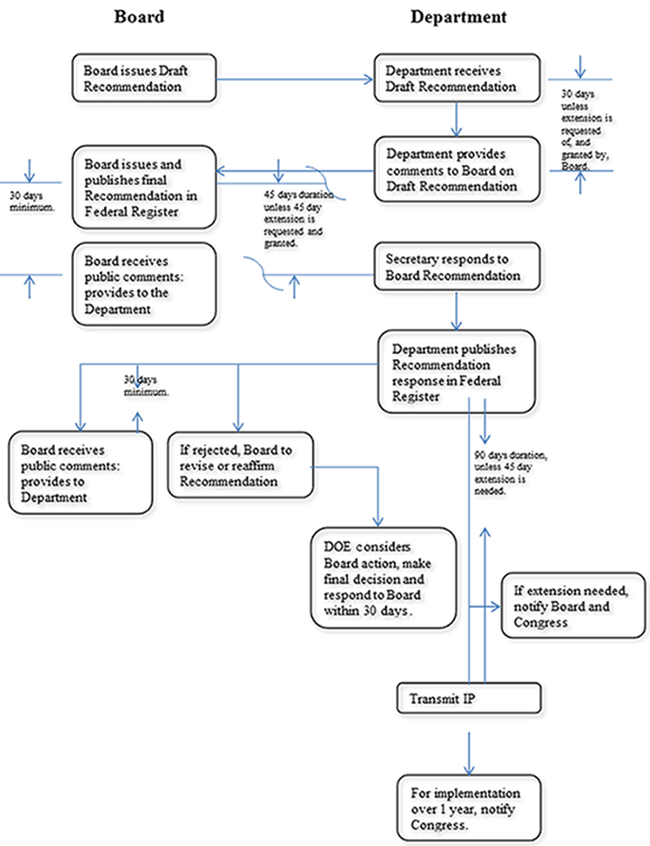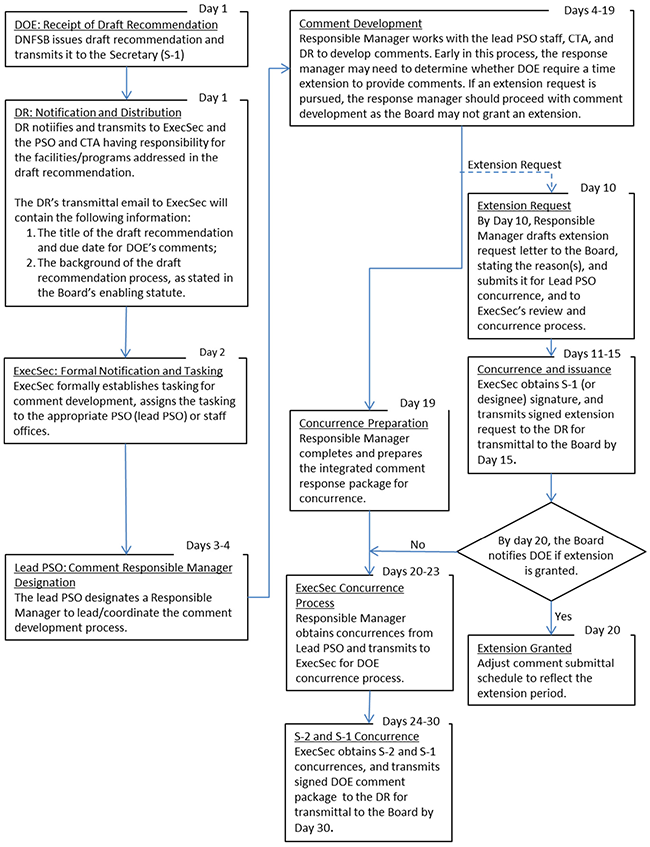DESK REFERENCE
Supporting DOE Order 140.1A, Interface with the Defense Nuclear Facilities Safety Board
1.0 BOARD RECOMMENDATIONS
The Board issues recommendations to the Secretary of Energy on issues or circumstances with respect to Department of Energy defense nuclear facilities, including operations of such facilities, standards, and research needs, that the Board determines needs to be resolved to ensure adequate protection of the public and worker safety and health. A general discussion of the process and recommended responsibilities is included in this section. Figure 1 provides an overview of the Board recommendation process. A listing of active and closed DNFSB Recommendations can be found on the DR Website (https://ehss.energy.gov/deprep/).
1.1 Draft Recommendation
Based on the legislation, the Board is required to transmit a draft recommendation to the Secretary of Energy for review prior to finalizing the recommendation for formal transmittal to the Secretary. Once a draft recommendation is received, the Secretary or his/her designee has 30 days to provide a response to the Board. There is no requirement that DOE must provide a response; however, it is the Department’s opportunity to go on record with its position prior to the Board’s issuance of a Final Recommendation. The Board may grant, upon request by the Secretary, additional time (e.g., an additional 30 days) for the Secretary to transmit comments to the Board.A senior-level manager will be designated to lead the Department’s review and, when necessary, response to the draft recommendation. The DR office works with the lead, together with cognizant DOE and/or contractor personnel to develop the Department’s response. If necessary, the Department may request to hold a meeting or teleconference with the Board staff to clarify the intent and data in the draft recommendation. This should be organized early in the review process such that necessary comments can be returned to the Board for their consideration. Items to consider during developing the Department’s response include, but are not limited to:
- Factual accuracy of the findings, supporting data, and analysis
- On-going Reviews
- Review of Legislative Authority
- DOE’s response will become part of the public record if a final Recommendation is issued by the Board – therefore it is important to provide context and clarity regarding DOE’s position
After the period of time in which the Secretary may provide comments (30 day period or extended period), the Board may transmit a final recommendation to the Secretary. The Board votes on whether to amend the draft recommendation based on the response from the Secretary, issue as-is, or not issue the final recommendation. Figure 2 provides an overview of the “draft recommendation” process.

Figure 1. Recommendation Process Overview
Process to Provide Comments on Draft Recommendations

Figure 2. Draft Recommendation Process Overview
1.3 Recommended Responsibilities for Responding to a Recommendation
DOE O 140.1A defines the primary responsibilities for Departmental Elements. The additional information and suggestions listed below are intended to provide effective management of the Department’s response to a recommendation and resulting implementation plan.
- The accountable Secretarial Officer should oversee the development of the Department’s response. If the recommendation is accepted, the accountable Secretarial Office should oversee development of the Implementation Plan (IP) and resolution of the applicable safety issues, through to the ultimate completion of the IP.
- The Secretary will designate a Responsible Manager, typically a Deputy Assistant Secretary or Head of Field Element or equivalent, to manage development and implementation of an adequate response; and, if necessary, an IP for addressing the accepted portions of the Board recommendation.
- The Responsible Manager should establish a response team to support the development and implementation of the Department’s response. The Responsible Manager should solicit early involvement of the Office of the General Counsel to support the response team in addressing legal interpretations, issues or procedural requirements. The DR’s office will designate an Issue Lead to support the Responsible Manager as a member of the response team.
- In addition to the items considered for the draft recommendation, the Response Team should, at a minimum, consider the following topics:
- Significant safety issues associated with the recommendation,
- Underlying causes and implications of these issues,
- Existing programs and activities that can be built upon,
- Strategic input from affected Departmental elements,
- Public comments forwarded from the Board,
- Costs and benefits associated with implementation, and
- Impact on Departmental programs and activities.
- The response team may seek discussions with one or more Board staff to fully understand the Board’s views regarding the underlying safety issues and potential resolution approaches. The team should consider the Board’s ideas and technical advice; but, reserve the right to make implementation decisions based on the Department’s sound technical expertise and risk analysis.
- Prior to obtaining concurrence on the Secretary’s response letter, the Responsible Manager should estimate the associated costs and contribution to safety and brief Departmental senior management concerning this information.

